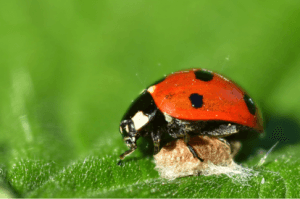A study conducted in France is beginning to shed light on the mechanisms by which green-eyed wasps can interfere with the neural circuit of the ladybugs they impregnate, ensuring that the ladybugs protect the cocoons of growing wasps (1).

A ladybug twitches on top of a wasp cocoon as a way to ward off predators. Source: Wikimedia Commons
The relationship between ladybugs, or “lady beetles” to entomologists, and the green-eyed wasp, Dinocampus coccinellae, is a classic parasitic-host relationship; one organism benefits at the cost of the other. The adult wasp initially infuses its egg inside the lady beetle, and after three weeks, a wasp larva emerges from the beetle’s abdominal area. The wasp larva then creates its cocoon under the lady beetle. Most baffling to scientists is the fact that the carcass of the lady beetle does not simply fall off of the cocoon. Instead, the beetle remains alive and twitches continuously on top of the growing larva. This ensures that predators do not target the larva until it matures into an adult wasp. Scientists have been searching for an explanation of how the wasps control the lady beetles after they have given birth (1,2).
Led by parasitologist Nolwenn Dheilly, formerly a postdoctoral fellow at the University of Perpignan in France, one research group is beginning to test the possibility of viral-based mind control. Dheilly hypothesized that the wasp may carry a virus that it passes down to the lady beetle that could instruct the synthesis of toxic proteins inside of the beetle. To test this hypothesis, Dheilly and his group sequenced several RNA transcripts in the body of the ladybug, searching for any abnormalities. Ultimately, the team stumbled upon foreign RNA transcripts in the brain created by a type of of Iflavirus, similar in composition to the poliovirus. This specific type of Iflavirus was abbreviated DCPV, for D. coccinellae paralysis virus (1).
The adult wasp seems to transmit the virus along with its egg to the lady beetle. Curiously, the virus doesn’t impact the lady beetle’s brain until after the wasp larva has emerged from its body. Dheilly’s team has found that certain immune genes are selectively silenced when the wasp larva is inside the lady beetle. Thus, while the larva remains inside the beetle, DCPV replicates in the brain of the beetle without any noticeable effects. However, as soon as the larva leaves the beetle’s body, the beetle’s immune system activates, attacking the viral-infected cells in the brain. This self-induced damage mediated by the beetle’s own immune system may provide a mechanism by which lady beetles become “zombie” bodyguards of larva cocoons (1).
Work still needs to be done to polish the study. Shelley Adamo, an insect specialist of Dalhousie University in Canada, states that, “[The study] does miss the final causal link.” Nonetheless, the implications of the study are important to the field of evolutionary biology. Dheilly, herself, says, “Whatever species you look at, there might be another, smaller organism that is within it and participating in its evolution and ecology” (1).
This study may help to better understand other parasite-host relationships on the molecular level. Also, it may contribute to the field of human neuroscience as scientists test parallels between the brain damage in the beetles’ motor control centers and damage with similar consequences in the human brain.
Sources:
1.Weiler N (10 Feb 2015). Wasp virus turns ladybugs into zombie babysitters. Retrieved February 14, 2015, from http://news.sciencemag.org/brain-behavior/2015/02/wasp-virus-turns-ladybugs-zombie-babysitters
2. Bar-Yam S (n.d.). Parasitic Relationships. Retrieved February 14, 2015, from http://www.necsi.edu/projects/evolution/co-evolution/parasites/co-evolution_parasite.html